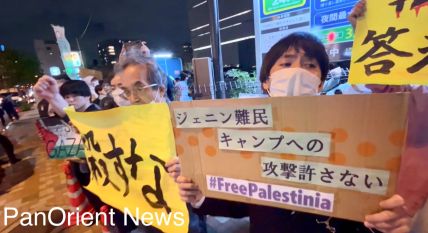|
|
Environment
Greenpeace Team Identifies ``High Contamination Levels`` in Minamisoma Vegetables
Wednesday, April 6, 2011

Yonezawa, Japan- (PanOrient News) Greenpeace said in a statement today that its radiation experts investigating impacts from the Fukushima nuclear crisis have discovered high levels of contamination in crops grown on the outskirts of Minamisoma city, raising further concerns over health risks to residents and a lack of official information outside the 20 km evacuation zone.
A Greenpeace radiation monitoring team tested spinach and other vegetables from the gardens of Minamisoma city residents, "revealing radiation levels many times higher than official limits," according to a statement by the group.
Total activity levels of 70,000 - 80,000 Bq/kg were found in spinach leaves from one garden, while levels of roughly 9,000 Bq/kg were found in cabbage from another. Based on the Japanese Ministry of Science (MEXT) reports, 20-30% of this radioactivity is caused by cesium-137, which is far above the Japanese government limit of 500 Bq/kg for vegetables. The limit for iodine-131 it is 2,000 Bq/kg.
Greenpeace has two small field teams carrying out radiation measurements, based in Yonezawa, but operating close to the Fukushima evacuation area. One team is focusing on a survey to map surface contamination and the on food and milk testing. Greenpeace is making requests through Japan’s media for food producers and consumers volunteering their food to be tested, which may aid them in future compensation claims.
The current official evacuation zone is 20 km around Fukushima, while between 20 km and 30 km is an area where people are advised to stay indoors or evacuate voluntarily.
“In several Minamisoma gardens, the vegetables were too contaminated for consumption,” said Greenpeace radiation expert Rianne Teule who is leading the food testing team. “The owner of one garden with contaminated spinach told us that she had received no information from authorities on the radiation risks to her crops, despite reports that government tests on plants in Minamisoma have been underway since March 18.”
The government has been publishing raw data from its own field monitoring, however, its assessment is currently far from comprehensive. Further radiation measurements made by the team in several parts of Minamisoma city show levels up to 4.5 microsievert per hour, which contrasts with the only official monitoring point in Minamisoma City which shows the relatively low levels of 0.7 microsievert per hour.
“While the Japanese government’s data is not necessarily incorrect, it is neither telling the full story, nor being adequately used to protect the health of people in Minamisoma” said radiation expert Jan Vande Putte, who is leading one of the Greenpeace radiation monitoring teams. “Our measurements, taken between government monitoring points, show elevated levels of contamination outside the official 20 km mandatory evacuation zone that indicate a risk to health, yet people in Minamisoma are only being advised to stay indoors or leave on a voluntary basis. This is unacceptable.”
The Mayor of Minamisoma, Katsunobu Sakurai, expressed his frustration to Greenpeace, citing a lack of reliable information or clear advice from Tokyo Electric Power Company (TEPCO) and the authorities regarding the risks this crisis is posing to his community.
“TEPCO has been irresponsible. This was clearly demonstrated when it took 11 days for it to speak to us after the accident. The government has also not supplied us with any kind of report that we can understand,” said Sakurai. “We are asking the government to not only to supply enough information about what has happened, but also that it guarantee that it will respond responsibly to possible future risks.”
Further measurements in the region, such as in a rural area near the village of Tsushima, 30 km from the Fukushima/Daiichi nuclear plant, and just outside the 30 km voluntary evacuation zone, also found contamination levels of up to 47 microsieverts per hour, compared to the 32.7 reported by the authorities. Exposure at this level means the maximum allowable dose for a year being achieved in less than 24 hours.
As the maximum allowable accumulated annual dose for members of the public is 1000 microsieverts, 47 microsieverts is 1.5 times that measured by the authorities, and high enough to expose someone to the maximum allowable dose in less than 24 hours.
“There continues to be an urgent need for not only reliable data from Japans government, but also meaningful interpretation and advice about the risks of radioactive contamination in food and the environment so the people affected by this disaster can protect both their health and their livelihoods,” said Vande Putte. “The authorities must urgently re-evaluate the evacuation zone around the Fukushima nuclear plant to better reflect radiation levels being found across the region.”
As part of the monitoring work, the team used selection of standard radiation monitoring equipment including Gamma spectrometer (Exploranium GR-135,) LB 200 Becquerel monitor, Geiger counters (Radex RD 1503, RadAlert,) and Contamination monitors (RADOS MicroCont, Berthold UMO.)
Lead by Rianne Teule, Greenpeace International Energy Campaigner and radiation expert, the teams include Greenpeace Germany Climate and Energy Unit Head Thomas Breuer, Greenpeace Belgium radiation safety expert Jan van de Putte and Greenpeace International Logistics Manager and qualified radiation safety advisor, Nikki Westwood.
Photo: Filed testing in Minimasoma. Christian Aslund / Greenpeace.
PanOrient News
© PanOrient News All Rights Reserved.
|
|

